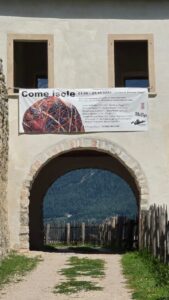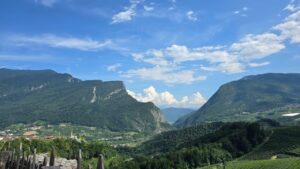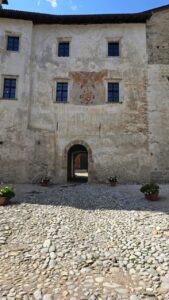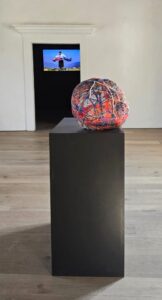 Castle Belasi is a medieval castle, an imposing fortress of great historical and architectural interest, located in Campodenno, Trento (Non-Valley), surrounded by an incredibly beautiful green landscape. Strategically positioned along the ancient Roman road of Rotaliana, the castle was built in the 14th century to guard the entrance to the valley. Initially belonging to the Counts of Tyrol, it later passed into the hands of the Khuen family, who transformed it into a majestic residence and inhabited it for centuries. Castel Belasi represents an important example of medieval architecture and a witness to the complex and fascinating history of the area.
Castle Belasi is a medieval castle, an imposing fortress of great historical and architectural interest, located in Campodenno, Trento (Non-Valley), surrounded by an incredibly beautiful green landscape. Strategically positioned along the ancient Roman road of Rotaliana, the castle was built in the 14th century to guard the entrance to the valley. Initially belonging to the Counts of Tyrol, it later passed into the hands of the Khuen family, who transformed it into a majestic residence and inhabited it for centuries. Castel Belasi represents an important example of medieval architecture and a witness to the complex and fascinating history of the area.
Short History of Castel Belasi
The earliest records of Castel Belasi date back to the early 14th century, a time when the Counts of Tyrol dominated the Trentino valleys. The castle was established as a stronghold of the County of Tyrol within the lands of the Prince-Bishops of Trento in the Non Valley, forming a unique Tyrolean enclave in Trentino.
Originally held by the Rubein family, loyal to the Counts of Tyrol, the castle was purchased by the Khuen family in 1368. The Khuens became so closely associated with the castle that they adopted the name “Khuen-Belasi”. Between the 15th and 16th centuries, they emerged as one of the most influential and wealthy families in the region, with members serving as bishops, politicians, and military commanders.

Under the Khuen’s ownership, Castel Belasi was transformed from a small fortress into a grand stronghold, featuring imposing outer walls and beautifully decorated interior halls. However, the castle faced two sieges: one by the rival Spaur family in 1415-20 and another by rebellious peasants in 1525.
The Khuen family wielded considerable power over the rural communities surrounding Castel Belasi, collecting a portion of their crops and expanding their landholdings to encompass extensive areas of farmland, vineyards, and forests.
The Decline and Restoration of Castel Belasi
In the 18th century, the Khuen-Belasi family, having obtained the title of “Counts of the Holy Roman Empire,” continued to embellish their fortress, decorating its interiors with refined stucco work and magnificent majolica stoves in the fashion of the time.
However, the Napoleonic Wars and the subsequent abolition of noble privileges led to the castle’s neglect. The family’s involvement in Austrian and Bavarian politics meant that Castel Belasi was primarily used as a summer residence and began to deteriorate.
Although the Khuens returned to reside at Belasi for several decades in the mid-20th century, the castle was abandoned once more in the 1950s. Stripped of its furnishings, it fell into a state of severe disrepair. By the late 1990s, the fortress was in a dire condition.
In 2000, the entire complex was purchased by the municipality of Campodenno, launching a major restoration project.
Details on Restoration
The castle presented serious structural problems mainly due to:
• Heavy materials and weak bonds: The construction techniques originally used were inadequate, with heavy materials and poorly resistant bonds.
• Lack of adequate foundations: The absence of solid foundations made the castle vulnerable to ground movements.
• Damage caused by natural events: The castle suffered significant damage due to natural events such as earthquakes, which further weakened the structure.
The most fragile parts of the castle were the ravelin and the guardhouse. Among the most important restoration interventions, a reinforced concrete band was built around the walls to strengthen the structure and prevent further collapses.

The frescoes uncovered during the restoration
Gli interventi di restauro del castello hanno portato alla luce un tesoro inestimabile: affreschi di straordinaria bellezza e significato. Dalle sale interne, dove emergono stemmi familiari e scene cavalleresche, alle pareti esterne, ornate da cicli mitologici che narrano le Metamorfosi di Ovidio e raffigurano episodi iconici come l’uccisione di Medusa da parte di Perseo, l’intero complesso è un vero e proprio scrigno d’arte. Particolarmente affascinanti sono gli affreschi rinascimentali attribuibili alla bottega del Fogolino, che celebrano la natura con rappresentazioni di frutta e musica, e danno vita a un curioso bestiario. Infine, la figura della Regina di Saba, simbolo di saggezza e potere, aggiunge un tocco di mistero e fascino a questo straordinario patrimonio artistico.

Castle Belasi Today is a Hub for Contemporary Art and Ecology
Today, Castel Belasi has taken on a new role as a Contemporary Art Center focused on eco-practices and thought. Looking towards the present and future, it opens a dialogue with contemporary art by hosting exhibitions dedicated to environmental issues under the artistic direction of Stefano Cagol. It also hosts concerts and events of various art forms and inspirations.
Visit Castle Belasi’s website https://www.castelbelasi.it/ to explore the current program and the Exhibition “As Islands” and Project Room “Theories of Clime” curated by Stefano Cagol.
Read my Review Exhition: “As Islands” and “Theories of Clime”
► View SourcesSources
Castel Belasi – Da Vedere – Castelli del Trentino – Trentino (visittrentino.info)
https://www.cultura.trentino.it/Luoghi/Tutti-i-luoghi-della-cultura/Castelli/Castel-Belasi
https://www.castelbelasi.it/

